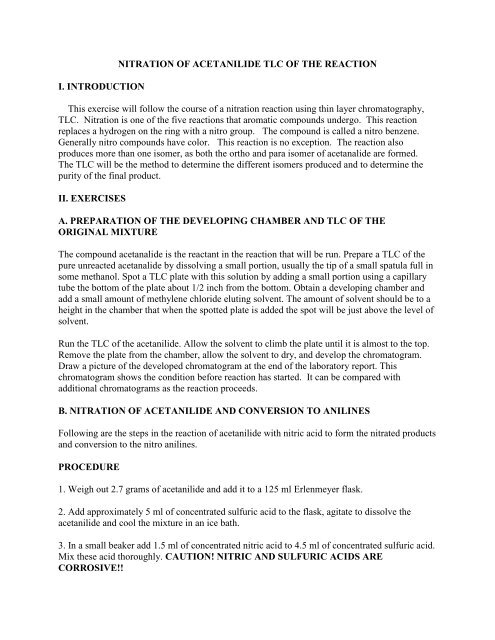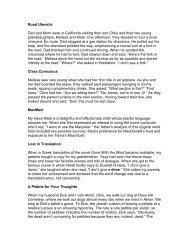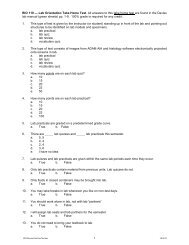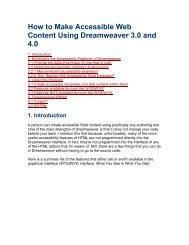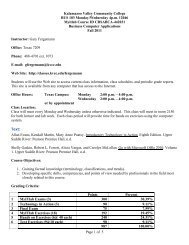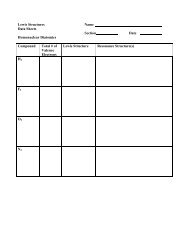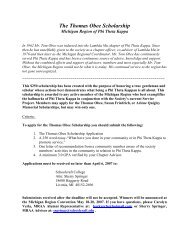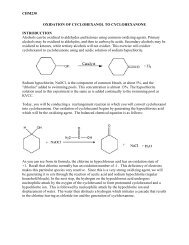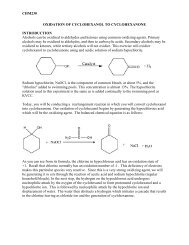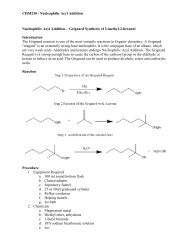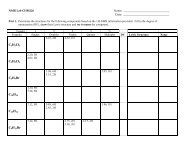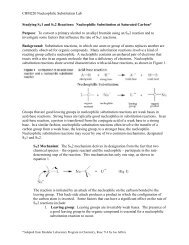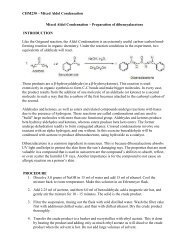NITRATION OF ACETANILIDE TLC OF THE ... - classes link 1
NITRATION OF ACETANILIDE TLC OF THE ... - classes link 1
NITRATION OF ACETANILIDE TLC OF THE ... - classes link 1
You also want an ePaper? Increase the reach of your titles
YUMPU automatically turns print PDFs into web optimized ePapers that Google loves.
I. INTRODUCTION<br />
<strong>NITRATION</strong> <strong>OF</strong> <strong>ACETANILIDE</strong> <strong>TLC</strong> <strong>OF</strong> <strong>THE</strong> REACTION<br />
This exercise will follow the course of a nitration reaction using thin layer chromatography,<br />
<strong>TLC</strong>. Nitration is one of the five reactions that aromatic compounds undergo. This reaction<br />
replaces a hydrogen on the ring with a nitro group. The compound is called a nitro benzene.<br />
Generally nitro compounds have color. This reaction is no exception. The reaction also<br />
produces more than one isomer, as both the ortho and para isomer of acetanalide are formed.<br />
The <strong>TLC</strong> will be the method to determine the different isomers produced and to determine the<br />
purity of the final product.<br />
II. EXERCISES<br />
A. PREPARATION <strong>OF</strong> <strong>THE</strong> DEVELOPING CHAMBER AND <strong>TLC</strong> <strong>OF</strong> <strong>THE</strong><br />
ORIGINAL MIXTURE<br />
The compound acetanalide is the reactant in the reaction that will be run. Prepare a <strong>TLC</strong> of the<br />
pure unreacted acetanalide by dissolving a small portion, usually the tip of a small spatula full in<br />
some methanol. Spot a <strong>TLC</strong> plate with this solution by adding a small portion using a capillary<br />
tube the bottom of the plate about 1/2 inch from the bottom. Obtain a developing chamber and<br />
add a small amount of methylene chloride eluting solvent. The amount of solvent should be to a<br />
height in the chamber that when the spotted plate is added the spot will be just above the level of<br />
solvent.<br />
Run the <strong>TLC</strong> of the acetanilide. Allow the solvent to climb the plate until it is almost to the top.<br />
Remove the plate from the chamber, allow the solvent to dry, and develop the chromatogram.<br />
Draw a picture of the developed chromatogram at the end of the laboratory report. This<br />
chromatogram shows the condition before reaction has started. It can be compared with<br />
additional chromatograms as the reaction proceeds.<br />
B. <strong>NITRATION</strong> <strong>OF</strong> <strong>ACETANILIDE</strong> AND CONVERSION TO ANILINES<br />
Following are the steps in the reaction of acetanilide with nitric acid to form the nitrated products<br />
and conversion to the nitro anilines.<br />
PROCEDURE<br />
1. Weigh out 2.7 grams of acetanilide and add it to a 125 ml Erlenmeyer flask.<br />
2. Add approximately 5 ml of concentrated sulfuric acid to the flask, agitate to dissolve the<br />
acetanilide and cool the mixture in an ice bath.<br />
3. In a small beaker add 1.5 ml of concentrated nitric acid to 4.5 ml of concentrated sulfuric acid.<br />
Mix these acid thoroughly. CAUTION! NITRIC AND SULFURIC ACIDS ARE<br />
CORROSIVE!!
4. Add the acid mixture to the original acetanilide/acid mix in 0.5 ml portions. Do this in the ice<br />
bath with mixing and do not allow the temperature of the mixture rise. The Erlenmeyer should<br />
remain cool to the touch. This should take about 20 minutes.<br />
5. Add approximately 25 ml of an ice/water mixture to the reaction flask.<br />
6. Take a sample of the reaction mixture with a capillary and spot a <strong>TLC</strong> plate.<br />
7. Place the reaction flask on a hot plate and heat until the color darkens and the solids go into<br />
solution. Do not heat excessively! This gentle boil should be maintained for about 20 minutes,<br />
after which the reaction vessel should be cooled in an ice bath.<br />
8. Add 25 ml of concentrated ammonia water to the cooled solution in 5 ml portions. The<br />
precipitate formed will be the final crude products. This suspension will be stored in the<br />
refrigerator until the next laboratory session.<br />
<strong>TLC</strong> of crude sample. The crystals recovered during the synthesis are a combination of<br />
ortho, meta and para nitroaniline.<br />
Add 2 ml of dichloromethane to a developing chamber. Cover the chamber.<br />
Prepare a solution of the crude sample dissolved in methanol. This should be<br />
about a 5% weight/volume concentration.<br />
Spot three plates with the crude sample and the reference samples of the ortho,<br />
meta and para isomers.<br />
Develop these and compare to determine the nature of your crude sample.<br />
9. Filter the product mixture from the suspension, and wash it with cold water. Allow the mixture<br />
to air dry.<br />
10. Recrystallization of the crude sample. The goal of the laboratory exercise was to synthesize<br />
paranitroaniline. The desired product can be recovered by fractional recrystallization.<br />
Recrystallize the crude product using approximately 10 ml of ethanol. To do this transfer the<br />
solid product to a beaker, add the ethanol and heat until all the solids are dissolved. Cool the<br />
mixture in an ice bath to promote crystallization and then filter the product.<br />
a. Transfer the crude sample to a small beaker. Add ethanol. The amount of ethanol<br />
required is the volume that will dissolve the entire sample in warm solvent. Heating<br />
is done on the surface of a hot plate, do not boil the ethanol.<br />
b. Heat until the crude sample is dissolved.<br />
c. Cool the mixture.<br />
d. Filter the suspension using filter paper, Buchner funnel and vacuum.<br />
e. Run the <strong>TLC</strong> of the recrystallized sample by following the steps in 1, b, c and d.
If the results of the activities in step 10 show that the recrystallized sample is pure<br />
paranitroaniline proceed to step 11, if not repeat step 10.<br />
11. Characterization of the product (label your vial just in case we need to use it next week).<br />
a) Determine the actual yield by weight<br />
b) Determine the melting point<br />
c) Run the IR spectra


